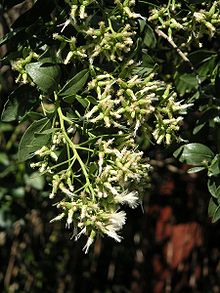Loading AI tools
Species of flowering plant in the daisy family Asteraceae From Wikipedia, the free encyclopedia
Baccharis halimifolia is a North American species of shrubs in the family Asteraceae. It is native to Nova Scotia, the eastern and southern United States (from Massachusetts south to Florida and west to Texas and Oklahoma),[2] eastern Mexico (Nuevo León, San Luis Potosí, Tamaulipas, Veracruz, Quintana Roo),[3] the Bahamas,[4] and Cuba.[5][6][7][8][9]
| Baccharis halimifolia | |
|---|---|
 | |
| Scientific classification | |
| Kingdom: | Plantae |
| Clade: | Tracheophytes |
| Clade: | Angiosperms |
| Clade: | Eudicots |
| Clade: | Asterids |
| Order: | Asterales |
| Family: | Asteraceae |
| Genus: | Baccharis |
| Species: | B. halimifolia |
| Binomial name | |
| Baccharis halimifolia | |
 | |
| Natural range of Baccharis halimifolia in United States + Bahamas | |
| Synonyms[1] | |
| |
Widely used common names include eastern baccharis, groundsel bush, sea myrtle, and saltbush. Consumption weed, cotton-seed tree, groundsel tree, menguilié, and silverling are also used more locally. In most of its range, where no other species of the genus occur, this plant is often simply called baccharis.

Baccharis halimifola was first described and named by Carl Linnaeus in his Species Plantarum, published in 1753. No subspecies or varieties are recognized within the species.
This species is the northernmost member of the large Western Hemisphere genus Baccharis in the aster family (Asteraceae).
Senecio arborescens, a Neotropical species, was confused with Baccharis halimifolia in the past.[citation needed]


Baccharis halimifolia is a fall-flowering shrub growing to about 12 ft (4 m) high and comparably wide, or occasionally a small tree. Its simple, alternate, thick, egg-shaped to rhombic leaves mostly have coarse teeth, with the uppermost leaves entire. These fall-flowering Baccharis plants are dioecious, with male and female flowers on separate individuals. Their flowers are borne in numerous small, compact heads in large leafy terminal inflorescences, with the snowy-white, cotton-like female flower-heads showy and conspicuous at a distance.[10][11]
The species is sometimes confused with the marsh-elder (Iva frutescens),[12] with which it often co-occurs, but the Baccharis has its leaves alternate, while those of the Iva are opposite.[10]
Baccharis halimifolia, usually found in wetlands, is unusually salt-tolerant, and often found along salty or brackish shores of marshes and estuaries, and the inland shores of coastal barrier islands. In Florida, it is also found along ditches, in old fields, and in other disturbed areas.[11] Other habitats in the northeastern United States include freshwater tidal marshes and open woods and thickets along the seacoast.[10]
The flowers produce abundant nectar that attracts various butterflies, including the monarch (Danaus plexippus).[11] These dense shrubs also provide wildlife food and cover.[11]

The species has become naturalized in Europe[11] and in New Zealand and considered invasive.[11]
The species features since 2016 on the list of Invasive Alien Species of Union Concern.[13] This means that import of the species and trade in the species is forbidden in the whole of the European Union.[14]
In Australia, B. halimifolia is an invasive species along the coast of southern Queensland and New South Wales.[5] As biological control the rust fungus Puccinia evadens[15] is used. Furthermore, the lepidoptera Hellinsia balanotes (Meyrick, 1908), Aristotelia ivae Busck, 1900, Lorita baccharivora Pogue, 1988 and Prochoerodes truxaliata (Guenée, 1858) were released for its biological control.
In the northeastern United States, the species has become common well inland of the shrub's natural range along various major highways where road salt is heavily used,[7] sometimes forming conspicuous displays when flowering in the fall, as along I-95 in Howard County, Maryland.
The seeds of Baccharis halimifolia are toxic to humans.[11]
Baccharis halimifolia is occasionally cultivated and is considered useful as a hedge or border as well as a specimen plant.[11] In southern Louisiana, it has been traditionally used as a medicine to treat inflamed kidneys and fever.[16]
Seamless Wikipedia browsing. On steroids.
Every time you click a link to Wikipedia, Wiktionary or Wikiquote in your browser's search results, it will show the modern Wikiwand interface.
Wikiwand extension is a five stars, simple, with minimum permission required to keep your browsing private, safe and transparent.